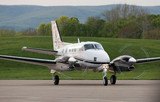July 7, 2025 - In a bold move to transform the future of aviation, the U.S. Department of Transportation (DOT) and the Federal Aviation Administration (FAA) have announced an accelerated plan to completely modernize the nation’s air traffic control (ATC) system — and they plan to do it in just three to four years.
This massive initiative, unveiled during a recent Industry Day following DOT Secretary Sean Duffy’s announcement, aims to deliver a next-generation ATC system faster than ever before. For owners, pilots, and operators of aircraft like the King Air 360, this overhaul is expected to have far-reaching impacts.
What’s Changing?
The FAA has issued a draft Request for Solutions (RFS) — a formal call for proposals from companies offering innovative technologies and integration solutions to modernize how aircraft are managed in U.S. airspace. This includes everything from updated radar and satellite surveillance to streamlined routing and real-time data systems.
While a public comment period was originally expected, the FAA is moving quickly. All proposals are now due by July 25 at 4:00 p.m. EDT, with a final vendor selection and contract award expected by September 30.
What It Means for King Air Operators
This isn't just a commercial airline issue — it affects all aircraft flying in controlled airspace, including general aviation, business jets, and turboprops like the King Air series. Here's how:
-
System-Wide Modernization: Whether you’re flying a King Air C90GTx or a 360ER, you'll likely experience changes in how you interact with ATC, from departure routing to in-flight communications and landing procedures.
-
Equipment Requirements: While exact mandates are still forthcoming, the overhaul may include upgraded avionics or data systems to meet future performance-based navigation or surveillance standards.
-
More Efficient Flights: The goal is a smarter, more responsive ATC system, which could mean smoother routing, fewer delays, and better fuel efficiency — especially valuable for operators managing tight schedules or long-range business trips.
-
Funding & Partnerships: The FAA is also asking for input on alternative funding options, including public/private partnerships, which could shape how costs and responsibilities are shared between government and operators.
Why the Rush?
ATC technology in the U.S. is decades old in many places. With increasing traffic, emerging airspace users (like drones and advanced air mobility), and the growing demand for real-time precision, there’s widespread agreement: it’s time for change.
The FAA’s push to complete the overhaul within four years is one of the most ambitious aviation infrastructure timelines in recent history.
Final Thoughts
If you're an owner, or operator, now is the time to stay informed and engaged. These changes will affect how you plan, file, and fly — and likely offer real benefits in the long run.
As Ed Bolen, president and CEO of the National Business Aviation Association (NBAA), put it:
“Prospective vendors and others with experience in modernizing ATC systems should provide feedback before the July 25 deadline and be prepared to submit proposals on an expedited timeframe.”
We'll be following this closely here at King Air Nation, and we’ll share updates as more details emerge.
Sources: FAA, DOT, NBAA

